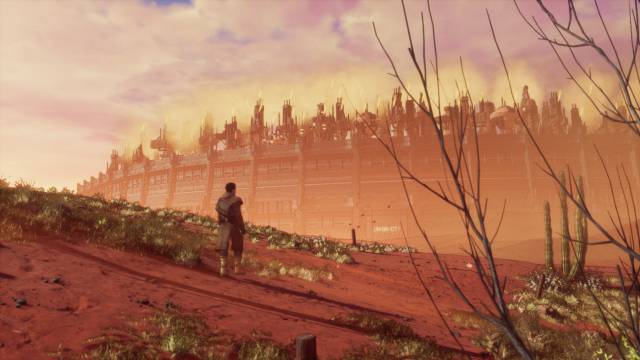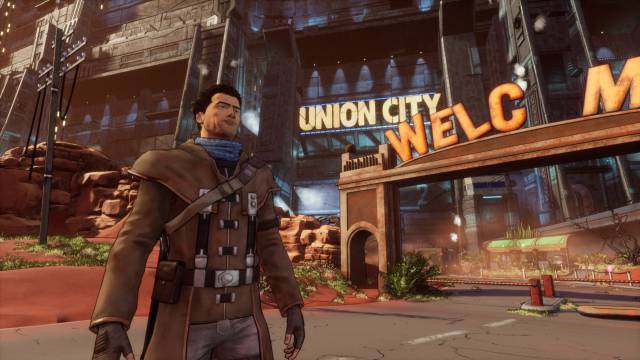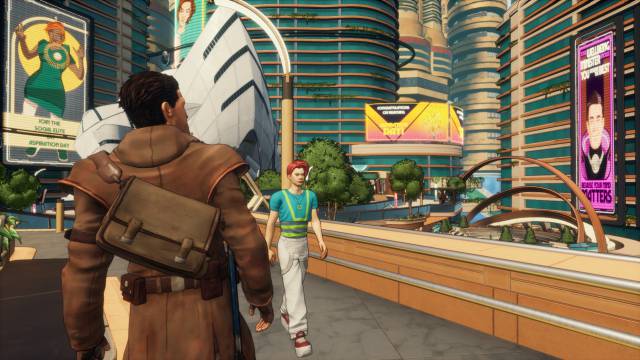
We take a look at Beyond a Steel Sky, the graphic adventure that follows the 1994 cult classic Beneath a Steel Sky, with Dave Gibbons back on board.
Beyond a Steel Sky is an exercise in honesty and enormous affection for one of the great classics of the graphic adventure genre. Revolution is a world-class developer, known mainly for its iconic Broken Sword saga, but it would be with her second title, Beneath a Steel Sky launched in 1994, with which they would make the final leap to middle stardom. The aforementioned classic was a superb sci-fi graphic adventure, in which the comic book world titan Dave Gibbons, famous among other things for drawing the masterpiece Watchmen, participated from the beginning. We affirm the exercise of honesty because it is not easy to bring back an intellectual property that came out 26 years ago and that is unknown to the vast majority of the public in the sector. Nor is it a risk-free decision to go for a production with great media within the genre of graphic adventure, since it does not enjoy the popularity of yesteryear. In 1994 this genre enjoyed enormous popularity, being one of the benchmarks within video games on PC. Not surprisingly, the second title of Revolution had a budget of around 50,000 euros at the time, crazy for an independent studio that launches its second proposal without having achieved resounding success with the first.
The enormous affection for the classic of which Beyond a Steel Sky is a continuation is clear from the moment we put ourselves at the controls of this. Charles Cecil and Dave Gibbons have joined forces again and you can see at all times the passion of both for what they are doing and the tremendous respect they feel for the magnificent work they launched in 1994. The good thing about this is that we are facing a title that will make anyone who plays Beneath a Steel Sky fall in love, full of references to that and knowing how to keep the spirit of the classic. But on the other hand, it is not at all necessary to have played that one to enjoy this continuation, being able to fully immerse ourselves in its proposal without having touched its predecessor. We are also facing a title that tries to please both veteran fans of the genre and those who come to it for the first time, being commendable for the efforts of its creators to try to please all audiences and to offer a product accessible to all. they. And of course, the effort to make an ambitious and mediated commitment to the genre of graphic adventure is always appreciated and praised when it has long since been in favor of the general public.
Thus, we are facing a good science fiction graphic adventure, which is committed to a three-dimensional development with direct control. This decision is striking after the more than irregular result of this approach in both Broken Sword 3 and 4, even more considering that Revolution returned to the classic development with pointer and two-dimensional for the fantastic Broken Sword 5, much better and more enjoyable than the previous two. Therefore, the use of this approach instead of one similar to that of the 1994 classic is surprising, but the truth is that this time the study has saved the ballot very well in this regard, and the problems that the adventure. Faced with a title that is more than correct and very entertaining, this is very far both in terms of puzzles and the development of the story and characters that its predecessor boasted. Beneath a Steel Sky is a classic and one of the best exponents of the graphic adventure genre, which still retains all its charm today, and we remind you that it is completely free in GOG in case you have not played it. This continuation is a very brave and honest bet, which seeks to please a wide spectrum of players, who lags somewhat behind the best options available today in the genre, but still manages to offer an attractive and enjoyable title.
Back to Union City
Our intrepid protagonist is the same from the 1994 game, Robert Foster. In a post-apocalyptic future where wars and pollution have devastated the planet, the human being was divided between the great city-states and the devastated wastelands that surround them. Foster grew up on one of these moors, where he ended up as a child after a helicopter incident. The inhabitants of the moor took care of him, and taught him extensive knowledge of technology and robotics. After the events of Beneath to Steel Sky, Robert Foster lives peacefully with his people in the desert moor known as The Gap. In an introductory comic-style sequence, we see how the occupants of a strange vehicle with legs kidnap one of the children of the Foster tribe right under their noses. Our brave protagonist rushes in for the rescue of the boy, and his inquiries following the trail lead him to Union City, the city-state where the events of the previous title took place, and where our adventure begins again. The surprise comes when we see that Union City has gone from being a dark and decadent repressive dystopia to a surprising utopia where it seems that everyone is happy. This is how our investigations begin to rescue Milo, the kidnapped child, and how could it be otherwise, they will bring us many revelations and surprises.
Beneath a Steel Sky was a stupendous science fiction work that dealt with a multitude of interesting subjects from a very attractive and revealing prism. This continuation tries to follow the same path, raising interesting topics such as state control of society, the role of technology in our lives, the search for happiness or what human beings really want to fully develop. The fact is that here they are not treated with the depth and success of their predecessor, remaining in a somewhat light plot that although attractive is not fully exploited or fully developed. It also suffers from some script holes and vital parts of it that have not been fully justified. Despite this, we are facing a correct science fiction story with a fully enjoyable message.

His predecessor pulled down the middle street between the two prevailing currents at the time, the wild and innocent humor of the Lucas classics and the more adult and deeper tone of most of Sierra’s adventures. This successor follows the same path, introducing hints of humor to a plot that tries to be transcendent, achieving a good result. At the character level, its protagonist stands out, a Robert Foster who is again a great character with whom it is easy to empathize and who does a great job almost completely supporting the development of the adventure. His good-natured and sarcastic robotic companion Joey also stands out, who will accompany us once the adventure is advanced and until the end of it, and that contributes much of the humorous counterpoint to the adventure. The rest of the secondary ones are not especially memorable, and in the end it is missed that the background of the utopia where the plot takes place is deepened and developed further, leaving the feeling that the surface is hardly scratched. What it does offer and everywhere are a multitude of references and connections with Beneath to Steel Sky that will delight the most veterans of the place who enjoyed it at the time, being very respectful of its legacy. The truth is that it is a real pleasure to see all those references and remember such a classic no less than 26 years later. Of course, as we have already commented, it is not necessary at all to have played its predecessor to fully enjoy this continuation.
Hacking not very satisfactory
At a playable level, it has opted for a direct control approach that fits in with the three-dimensional development used on this occasion, and that marries very well with control pad operation that is perfectly adapted to make the title accessible to console users as well. So, we will move through three-dimensional environments, and when we get close to some interacting element of the environment, be it an object or a character, a circle will appear on it. By pressing a button, a drop-down menu will open with a series of actions to perform, usually examining, speaking, using or inventory to use some element of it. On certain occasions certain contextual actions will also appear. Development is the classic of the genre: talking to characters to obtain information and unlock events, search for objects and use them in the right place and other actions that we usually carry out in a graphic adventure.

To try to give the adventure an air of modernity and freshness, a hacking tool has been added that will allow us to hack various elements of the scenario to our advantage. The system uses geometric shapes similar to the flow charts used in computing. Certain elements of the stage have their own diagram pieces, and by exchanging their contents we can modify their behavior or operating mode to our advantage. At a certain point, these types of puzzles gain almost the entire weight of the adventure instead of the more traditional inventory puzzles, and the truth is that we have not been convinced enough nor have we found them too satisfactory. In the end they end up being repetitive and tiresome, since practically we should always do the same: look for two elements to exchange the actions of one and the other and change them in their diagram, without further complication or any depth at the level of puzzle design. This is exacerbated on some occasions by the cumbersome process, since the hacking tool has a limited range of action, and on several occasions the devices to be hacked are in motion or we must even use a third party as a bridge between the one that has the action that we want to transfer and the final recipient of it. The system has potential, but it quickly falls into repetition and never poses satisfactory or complex puzzles, which is serious given that, as we have already mentioned, its role in the adventure is very high.
Where the game is correct is with an integrated hint system that works very well and is very helpful. Of course, the most purists of the genre will totally deny it, and in any case it is totally optional. We can access it through the pause menu at any time, and it will gradually give us clues for each point of the adventure. At first it will give us a slight hint, and it will force us to wait 30 seconds if we want to be given more precise indications each time, so it invites us to go unraveling for ourselves the entanglements that it poses. The difficulty of the title is not excessively high, and since it is developed in quite limited environments where we have in our hands all the necessary elements to advance, it is likely that we do not need to use the hint system, but in any case, being an addition optional is appreciated and is very well implemented. The excellent translation of all the texts into Spanish will help us to enjoy the adventure without impediments to older people due to language issues. And as we have already mentioned, the game is controlled perfectly with the control pad, so console users have nothing to fear about it.

A wasted city
Visually, as already discussed, we have left behind the sprites and two-dimensional environments of the past to fully embrace all 3 dimensions. And without facing a leading graphic title, far from it, the truth is that the change has not been bad for the saga. The full involvement in the development of the Mr. Gibbons title is noted again, this time highlighted by the light cartoon finish with some cell shading that the graphics of the game present. The environments are beautiful and well worked, and leave us the odd truly beautiful view. Foster’s modeling is correct and adequately expressive, although it is true that other characters are not finished with the same good work, and the modeling of the characters that swarm around Union City are repeated in excess. It also highlights how clean the entire screen is from outside elements, leaving the user interface invisible until it is necessary to use it, which together with the speech bubbles reinforce the comic style of the game. In any case, given the genre we are talking about, it must be recognized that we are dealing with graphic work that is more than competent and attractive, with the touch of quality and distinction that Dave Gibbons has managed to contribute, who once again pours enormous love and care for his work in this video game.
We must highlight that yes a couple of defects that somewhat tarnish the visual section of the game. On the one hand, it is noted that the title would have been useful for a couple of more weeks of testing and polishing, because without being something excessively serious, if we have encountered a graphic bug that makes the experience somewhat ugly. The studio is aware of this and is rolling out patches to fix it. On the other hand, the title excessively abuses the same locations, since almost all environments where the adventure takes place can almost be counted on the fingers of one hand, and some of them we will visit several times. In addition to the repetitiveness that this supposes, it leaves us wanting to visit more areas and get to know better that city of Union City that so many attractive locations could have offered, and that we hardly got to intuit in the 10 hours we will spend in it. In the sound section we find a great job in the voices of each and every one of the characters, always being consistent with all of them and helping to highlight their personalities, especially in the case of Foster and Joey. The soundtrack complies without excessive fanfare, leaving some good time with a somewhat more inspired and epic theme.

CONCLUSION
Beyond a Steel Sky is a good graphic adventure that is very respectful of the 1994 classic of which it is a continuation, being a great tribute and being full of references to it. You can see the enormous affection and love that both Charles Cecil and Dave Gibbons feel for Beneath to Steel Sky, and they are aware that it is a cult title that many of us have in our hearts and we are excited to see back. We must also appreciate the enormous exercise in honesty that it brings to bring him back 26 years later, even more so when the graphic adventure does not enjoy today or far from the popularity of yesteryear. We must also thank the fact that despite all this they have released a totally enjoyable game if we do not know its predecessor, and that it also seeks to update the formula to a certain extent and offer a product accessible to everyone without us being veteran adventure players graphics. It is a pity that at a playable level it stays very half-gas, with an excess of puzzles with the mechanics of hacking that soon become repetitive and tedious, and at the level of history it barely delves into the world that it poses and offers us a rather simpler than its predecessor. Despite this, we are facing a correct exponent of the genre with a science fiction plot with a message and that addresses burning issues, especially recommended for novices in the genre or lovers of the cult classic of 1994, since the title will equally content both of them.
THE BEST
- It is a heartfelt tribute to the 1994 classic, and despite this totally enjoyable if we have not played it.
- It is appreciated to see a graphic adventure with these production values today.
- The protagonist couple has a lot of charisma.
WORST
- The abuse of hacking puzzles that quickly become repetitive and tedious.
- The plot does not develop as much as it should and it does not finish exploiting the topics it deals with.
- Excessive repetition of scenarios.
- Some other graphic bug.
Okay
It meets the expectations of what is a good game, it has quality and does not have serious flaws, although it lacks elements that could have taken it to higher levels.
